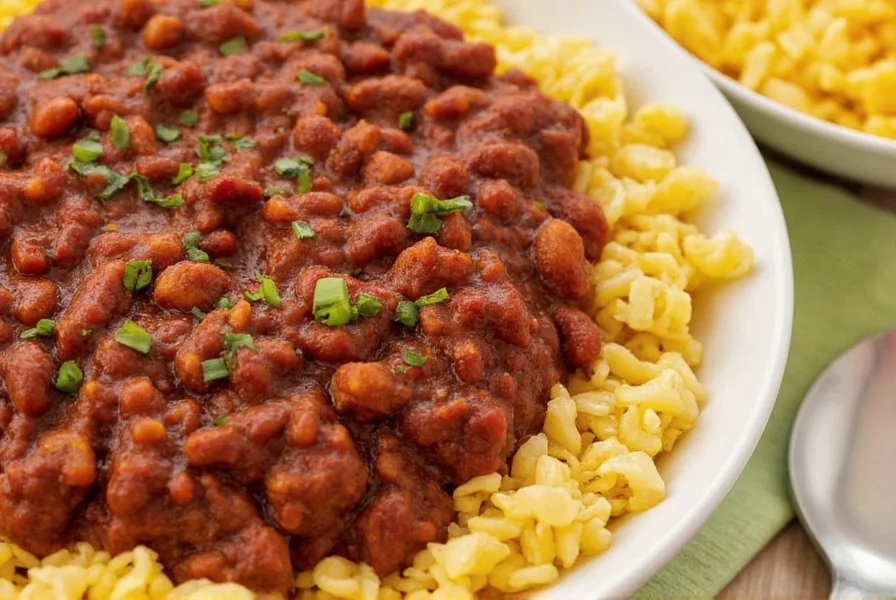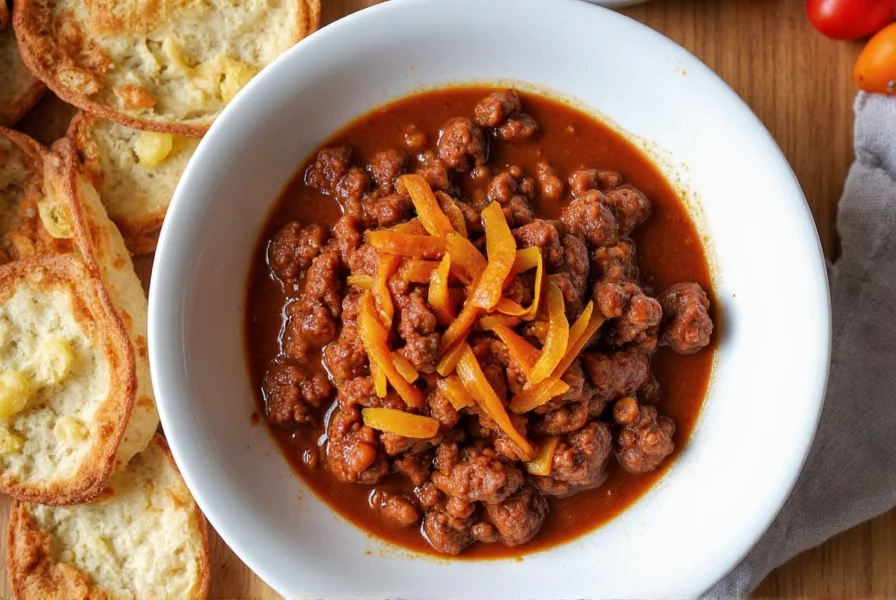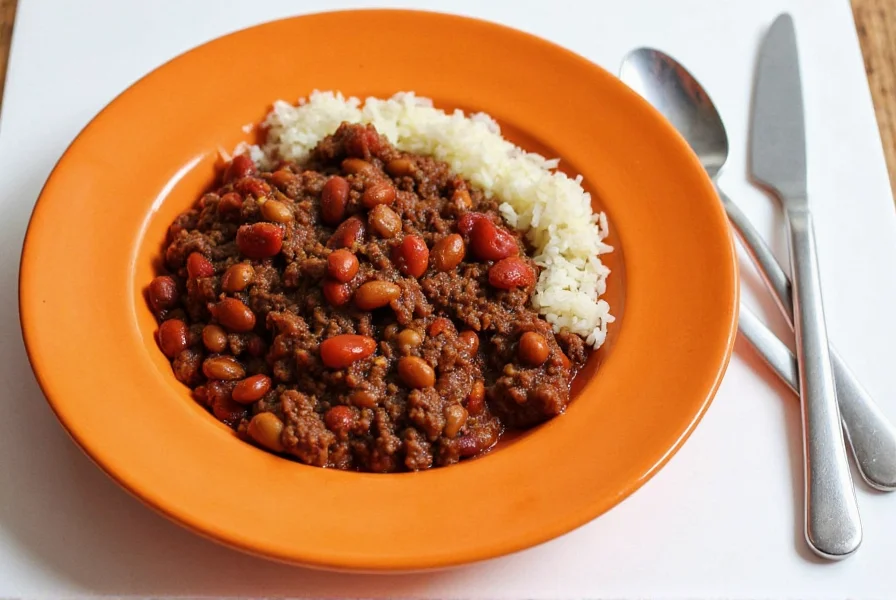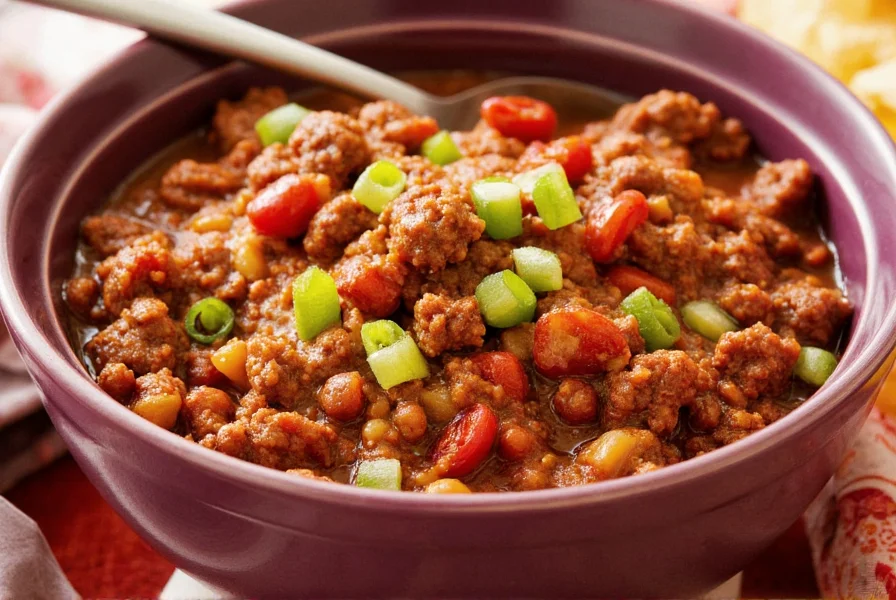Table of Contents
Classic Ground Beef Chili Recipe
Ready in 30 minutes, this classic ground beef chili delivers rich, smoky flavor with perfect spice balance. Follow these precise measurements for restaurant-quality results every time.
Ingredients
- 1 lb (450g) ground beef (80% lean / 20% fat)
- 1 medium yellow onion, finely diced (1 cup)
- 3 cloves garlic, minced
- 2 tbsp chili powder (blend of ancho, guajillo, and cayenne)
- 1 tbsp ground cumin
- 1 tsp smoked paprika
- 1/2 tsp cayenne pepper (adjust to heat preference)
- 1 tbsp tomato paste
- 1 (15 oz) can diced tomatoes with juice
- 1 (15 oz) can kidney beans, drained and rinsed
- 1 cup beef broth
- 1 tbsp olive oil
- 1 tsp apple cider vinegar
- Salt and black pepper to taste
- Optional toppings: shredded cheddar, sour cream, green onions
Step-by-Step Instructions
- Sear the beef: Heat olive oil in a Dutch oven over medium-high heat. Add ground beef and cook until well-browned (5-7 minutes), breaking into small pieces. Drain excess fat.
- Cook aromatics: Add diced onion and garlic. Sauté until translucent (3 minutes).
- Toast spices: Stir in chili powder, cumin, smoked paprika, and cayenne. Cook for 1 minute while stirring to release oils.
- Build base: Add tomato paste and cook for 30 seconds. Pour in diced tomatoes, kidney beans, and beef broth. Bring to a simmer.
- Simmer: Reduce heat to low, cover, and simmer for 20 minutes. Stir occasionally.
- Finish: Stir in apple cider vinegar. Season with salt and pepper to taste. Serve hot with toppings.

Spice Basics for Chili Lovers
Understanding spice profiles is key to balancing chili flavors. Here's how each component contributes:
| Spice | Heat Level | Flavor Profile | Best For |
|---|---|---|---|
| Ancho Chili Powder | Mild | Fruity, sweet, deep | Adding depth without heat |
| Guajillo Chili Powder | Medium | Berry-like, tart, rich | Complex layers of flavor |
| Cayenne | Very Hot | Sharp, biting heat | Kick-ass heat lovers |
| Smoked Paprika | Mild | Smoky, slightly sweet | Balance and aroma |
| Cumin | None | Earthy, nutty | Foundational flavor |
Meat Matters: Choosing Your Ground Beef
Ground beef quality directly impacts chili texture and flavor. Key considerations:

- Fat Content: 80% lean / 20% fat is ideal. The fat renders during cooking, creating rich flavor and preventing dryness.
- Texture: Coarse grind (1/4 inch) works best. Fine grind creates dense, mushy texture.
- Source: Grass-fed offers cleaner taste; grain-fed provides richer fat profile.
Chili Variations to Try
Customize your chili with these authentic regional styles:
Texas-Style Chili (No Beans)
- Ingredients: Replace kidney beans with 1 lb diced beef chuck, add 2 dried ancho chilies (soaked and blended)
- Method: Simmer 2 hours uncovered for concentrated flavor. Serve with cornbread.
Black Bean & Sweet Potato Chili
- Ingredients: Replace kidney beans with 1 can black beans, add 1 diced sweet potato, 1 tsp cinnamon
- Method: Add sweet potato with tomatoes. Simmer 25 minutes until tender. Top with avocado.
Frequently Asked Questions About Authentic Chili
What's the most important step for authentic chili flavor?
Toasting your spices properly is crucial. After browning your beef and cooking the aromatics, add your dry spices directly to the pot and stir for 30-60 seconds until fragrant. This 'torching' step unlocks essential oils and creates deeper flavor compounds that simmering alone can't achieve. Never skip this step—it transforms raw spice notes into complex, layered flavors.
Why does my chili taste flat even with all the spices?
Flat-tasting chili usually lacks proper acid balance or layering. Authentic chili requires balancing heat with brightness—try adding 1-2 teaspoons of apple cider vinegar or fresh lime juice during the final 15 minutes of cooking. Also ensure you're toasting spices properly and using at least three different chili varieties (like ancho, guajillo, and cayenne) for complexity rather than relying on single chili powder.
Can I make authentic chili without beans?
Absolutely. Traditional Texas-style chili never includes beans—they're considered filler that dilutes the rich meat flavor. For authentic meat-forward chili, focus on high-quality ground beef (80/20 fat ratio), multiple dried chili varieties, and slow simmering. Beans can be served on the side if desired, but purists believe they disrupt the chili's natural texture and flavor concentration.
How long should I simmer chili for maximum flavor?
For truly authentic flavor, simmer uncovered for at least 2 hours. The magic happens between 90 minutes and 3 hours when collagen breaks down, flavors meld, and excess liquid reduces to create concentrated depth. Stir occasionally to prevent sticking. If using tougher cuts like chuck, extend to 3-4 hours. Remember: chili always tastes better the next day as flavors continue to develop.
What's the secret ingredient professional chefs use?
Beyond the chipotle and cocoa mentioned in our secret weapons, many chefs use a small amount of fish sauce (1 teaspoon per batch). It adds umami depth without making the chili taste fishy. Alternatively, a strip of orange zest (removed before serving) provides subtle citrus notes that elevate the entire flavor profile without overpowering. Both ingredients help balance the heat and richness.
Buying Guide: Must-Have Tools and Ingredients
Equip your kitchen for perfect chili with these essentials:
| Product | Features | Target Audience | Occasion |
|---|---|---|---|
| Le Creuset Dutch Oven | Heavy-duty, heat retention, enamel coating | Home cooks, chili enthusiasts | Weeknight dinners, tailgating, family meals |
| Staub Cast Iron Skillet | Excellent sear, self-basting lid | Grill masters, foodies | High-heat cooking, indoor grilling |
| Kuhn Rikon Microplane Zester | Sharp, ergonomic handle | Chefs, home bakers | Everyday use, cocktail garnishes |
| Breville Immersion Blender | Powerful motor, detachable head | Busy parents, quick dinner fans | Blending soups, sauces, smooth chilis |













 浙公网安备
33010002000092号
浙公网安备
33010002000092号 浙B2-20120091-4
浙B2-20120091-4